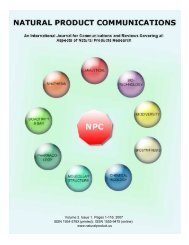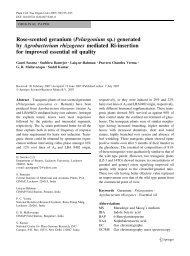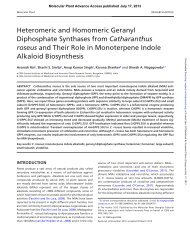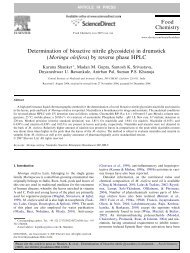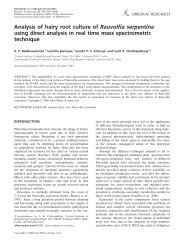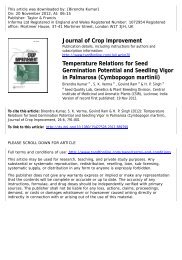Immunomodulatory effect of extracts of Hibiscus ... - ResearchGate
Immunomodulatory effect of extracts of Hibiscus ... - ResearchGate
Immunomodulatory effect of extracts of Hibiscus ... - ResearchGate
Create successful ePaper yourself
Turn your PDF publications into a flip-book with our unique Google optimized e-Paper software.
IMMUNOMODULATORY EFFECT OF HIBISCUS SABDARIFFA 667in situ though with tightly controlled and balanced activity(Fujiwara and Kobayashi, 2005). Concentrations <strong>of</strong>the TNF-α, though not exhibiting dose-dependence inany <strong>of</strong> the extract group, were lowest in the aqueousextract at 300 mg/kg. With the ethanol extract, therewas a noticeable reduction in the amount <strong>of</strong> TNF-α asthe dose <strong>of</strong> the extract increases. The fractions alsoshowed a significant reduction in the production <strong>of</strong> TNFαwhen compared with the negative control and thevehicle control group. In none <strong>of</strong> the groups, however,was TNF-α concentration as high as in the negative orvehicle groups (Tables 1 and 2). Previous studies haveshown that the <strong>extracts</strong> and some <strong>of</strong> its constituentshave in vitro activity against some carcinoma cell lines(Lin et al., 2005; Hou et al., 2005) and in vivo activityagainst atherosclerosis in animal models (Chen et al.,2003). Previous studies have also implicated highlevels <strong>of</strong> TNF-α in clinical diagnoses <strong>of</strong> atherosclerosis(Bruunsgaard et al., 2000) suggesting that low TNF-αmay lead to reduction <strong>of</strong> calcification observed withatherosclerosis (Tintut et al., 2000), an activity that hasbeen confirmed with <strong>extracts</strong> <strong>of</strong> <strong>Hibiscus</strong> sabdariffa inan atherosclerotic animal model (Chen et al., 2003)though prolonged exposure to TNF-α may lead to someantiinflammatory <strong>effect</strong>s.Interleukin 10 (IL-10), usually referred to as an antiinflammatorycytokine, was high in the serum <strong>of</strong> animalson 300 mg/kg <strong>of</strong> <strong>extracts</strong> comparable to levamisole (thepositive control). Animals administered with A300 mg/kg had the highest concentrations bearing out the results<strong>of</strong> an earlier study by Ogundipe et al. (1998) that thewater extract <strong>of</strong> the dried calyx <strong>of</strong> H. sabdariffa hasantiinflammatory activity in carrageenan-induced ratpaw oedema. The insoluble fraction produced highamount <strong>of</strong> IL-10 in a dose-dependent manner, and thismay well be one <strong>of</strong> the fractions responsible for theimmunostimulatory activity. The residual water-solublefraction at 100 mg/kg body weight also caused an increasein IL-10 concentration at 100 mg/kg. IL-10 hasbeen known to down-regulate factors present in inflammationand tumors. An extract or chemical compoundthat could increase antiinflammatory interleukin, forexample, IL-10, and reduce the formation <strong>of</strong> a proinflammatoryfactor such as TNF-α may be found to be<strong>of</strong> great usefulness in preventing or reducing formation<strong>of</strong> atherosclerotic plaques, may also help in reduction<strong>of</strong> stress, and may also possess antitumour activity.The low level and high level <strong>of</strong> TNF-alpha and IL-10respectively confirmed that the <strong>extracts</strong> and the fractionstested, apart from having these biological properties,may also stimulate immunomodulation throughthe activities <strong>of</strong> cytoleukines.CONCLUSIONThe study revealed that, to some extent the <strong>extracts</strong>,and to a large extent, two fractions <strong>of</strong> the plant possessthe ability to stimulate the immune system in vivo.The activity may be as a result <strong>of</strong> interplay between theproduction <strong>of</strong> interleukin 10, inhibition <strong>of</strong> tumor necrosisfactor-alpha and the <strong>effect</strong> <strong>of</strong> B-cells responsible forantibody production.One <strong>of</strong> the fractions showed good possibilities <strong>of</strong>being developed into a drug entity that may be used tostimulate immunity as an adjunct to therapy in immunosuppresseddisease conditions. However, the extract, asit is taken in humans as a beverage may be <strong>of</strong> benefit inenhancing immunity. Further studies need to be doneto evaluate the exact mechanism <strong>of</strong> action.AcknowledgementsThis study was jointly sponsored by the Department <strong>of</strong> Biotechnology(India) and The Academy <strong>of</strong> Sciences in Developing Countries(TWAS) for the DBT/TWAS postdoctoral fellowship awarded tothe first author. The authors also acknowledge the support in form<strong>of</strong> facilities provided by the Central Institute <strong>of</strong> Medicinal andAromatic Plants, Lucknow, India.REFERENCESAli BH, Mousa HM, El-Mougy S. 2003. The <strong>effect</strong> <strong>of</strong> a waterextract and anthocyanins <strong>of</strong> <strong>Hibiscus</strong> sabdariffa L onparacetamol-induced hepatoxicity in rats. Phytother Res17: 56–59.Amin A, Hamza AA. 2005. Hepatoprotective <strong>effect</strong>s <strong>of</strong> <strong>Hibiscus</strong>,Rosmarinus and Salvia on azathioprine-induced toxicity inrats. Life Sci 77: 266–278.Bruunsgaard H, Skinhoj P, Pedersen AN, Schroll M,Pedersen BK. 2000. Ageing, tumor necrosis factor-alpha(TNF-alpha) and atherosclerosis. Clin Exp Immunol 121:255–260.Chang YC, Huang HP, Hsu JD, Yang SF, Wang CJ. 2005.<strong>Hibiscus</strong> anthocyanins rich extract-induced apoptotic celldeath in human promyelocytic leukemia cells. Toxicol ApplPharmacol 205: 201–212.Chen CC, Hsu JD, Wang SF et al. 2003. <strong>Hibiscus</strong> sabdariffaextract inhibits the development <strong>of</strong> atherosclerosis incholesterol-fed rabbits. J Agric Food Chem 51: 5472–5477.Falade OS, Otemuyiwa IO, Oladipo OO, Oyedapo OO, AkinpeluBA, Adewusi SRA. 2005. The chemical composition andmembrane stability activity <strong>of</strong> some herbs used in localtherapy for anaemia. J Ethnopharmacol 102: 15–22.Fujiwara N, Kobayashi K. 2005. Macrophages in inflammation.Curr Drug Targets Inflamm Allergy 4: 281–286.Herrera-Arellano A, Flores-Romero S, Chavez-Soto MA,Tortoriello J. 2004. Effectiveness and tolerability <strong>of</strong> a standardizedextract from <strong>Hibiscus</strong> sabdariffa in patients withmild to moderate hypertension: a controlled and randomizedclinical trial. Phytomedicine 11: 375–382.Hou DX, Tong X, Terahara N, Luo D, Fujii M. 2005. Delphinidin3-sambubioside, a <strong>Hibiscus</strong> anthocyanin, induces apoptosisin human leukemia cells through reactive oxygen speciesmediatedmitochondrial pathway. Arch Biochem Biophys440: 101–109.Inngjerdingen K, Nergård CS, Diallo D, Mounkoro PP, PaulsenBS. 2004. An ethnopharmacological survey <strong>of</strong> plants usedfor wound healing in Dogonland, Mali, West Africa.J Ethnopharmacol 92: 233–244.Lin HH, Huang HP, Huang CC, Chen JH, Wang CJ. 2005. <strong>Hibiscus</strong>polyphenol-rich extract induces apoptosis in human gastriccarcinoma cells via p53 phosphorylation and p38 MAPK/FasL cascade pathway. Mol Carcinogen 43: 86–89.Lin WL, Hsieh YJ, Chou FP, Wang CJ, Cheng MT, Tseng TH.2003. <strong>Hibiscus</strong> protocatechuic acid inhibits lipopolysaccharideinducedrat hepatic damage. Arch Toxicol 77: 42–47.Odigie IP, Ettarh RR, Adigun SA. 2003. Chronic administration<strong>of</strong> aqueous extract <strong>of</strong> <strong>Hibiscus</strong> sabdariffa attenuateshypertension and reverses cardiac hypertrophy in 2K-1Chypertensive rats. J Ethnopharmacol 86: 181–185.Copyright © 2008 John Wiley & Sons, Ltd. Phytother. Res. 22, 664–668 (2008)DOI: 10.1002/ptr



